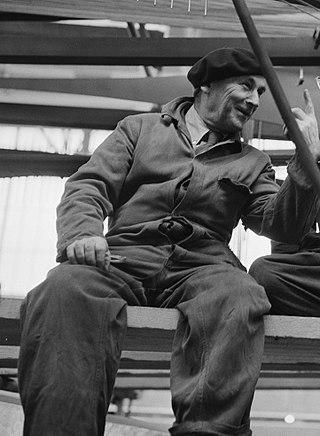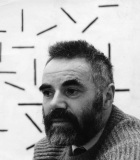Related Research Articles

Naum Gabo, born Naum Neemia Pevsner was an influential sculptor, theorist, and key figure in Russia's post-Revolution avant-garde and the subsequent development of twentieth-century sculpture. His work combined geometric abstraction with a dynamic organization of form in small reliefs and constructions, monumental public sculpture and pioneering kinetic works that assimilated new materials such as nylon, wire, lucite and semi-transparent materials, glass and metal. Responding to the scientific and political revolutions of his age, Gabo led an eventful and peripatetic life, moving to Berlin, Paris, Oslo, Moscow, London, and finally the United States, and within the circles of the major avant-garde movements of the day, including Cubism, Futurism, Constructivism, the Bauhaus, de Stijl and the Abstraction-Création group. Two preoccupations, unique to Gabo, were his interest in representing negative space—"released from any closed volume" or mass—and time. He famously explored the former idea in his Linear Construction works (1942-1971)—used nylon filament to create voids or interior spaces as "concrete" as the elements of solid mass—and the latter in his pioneering work, Kinetic Sculpture (1920), often considered the first kinetic work of art.

Lyubov Sergeyevna Popova was a Russian-Soviet avant-garde artist, painter and designer.

Edward Alexander Wadsworth was a British artist initially associated with the Vorticism movement. In the First World War he was part of a team involved in the transfer of dazzle camouflage designs to ships for the Royal Navy. After the war his maritime landscapes and still-life compositions using tempera were infused with a surrealistic mood - although he never exhibited with the British surrealists. In the early thirties and in the early forties his work was mainly abstract. He made a significant contribution to the development of modern art in Britain in the inter-war years.

Constructivism is an early twentieth-century art movement founded in 1915 by Vladimir Tatlin and Alexander Rodchenko. Abstract and austere, constructivist art aimed to reflect modern industrial society and urban space. The movement rejected decorative stylization in favour of the industrial assemblage of materials. Constructivists were in favour of art for propaganda and social purposes, and were associated with Soviet socialism, the Bolsheviks and the Russian avant-garde.

Henryk Stażewski was a Polish painter, visual artist and writer. Stażewski has been described as the "father of the Polish avant-garde" and is considered a pivotal figure in the history of constructivism and geometric abstraction in Central and Eastern Europe. His career spanned seven decades and he was one of the few prominent Polish artists of the interwar period who remained active and gained further international recognition in the second half of the 20th century.

Edwin John Victor Pasmore, CH, CBE was a British artist. He pioneered the development of abstract art in Britain in the 1940s and 1950s.
Kenneth Laurence Martin, was an English painter and sculptor who, with his wife Mary Martin and Victor Pasmore, was a leading figure in the revival of Constructionism.
John Ernest was an American-born constructivist abstract artist. He was born in Philadelphia, in 1922. After living and working in Sweden and Paris from 1946 to 1951, he moved to London, England, where he lived and worked from 1951. As a mature student at Saint Martin's School of Art he came under the influence of Victor Pasmore and other proponents of constructivism. During the 1950s, Ernest exhibited with the British Constructivist art movement. Ernest later became a core member of the Systems Group.
Anthony Cedric Graham Hill, also known as Achill Redo, was an English artist, painter, relief-maker, and mathematician, originally a member of the post-World War II British art movement termed the Constructionist Group whose work was essentially in the international constructivist tradition.

Peter Lowe is an English artist, born in Hackney, London. His work is systematic, constructivist and concrete. It is mainly exhibited and appreciated in Europe, where it is held in many national collections.
Paule Vézelay (1892–1984) was a British painter, known for her abstract art.
Gillian Mary Wise was a British artist devoted to the application of concepts of rationality and aesthetic order to abstract paintings and reliefs. Between 1972 and 1990 she was known as Gillian Wise Ciobotaru.
Robert Adams was an English sculptor and designer. Whilst not widely known outside of artistic circles, he was nonetheless regarded as one of the foremost sculptors of his generation. In a critical review of a retrospective mounted by the Gimpel Fils gallery in London in 1993, Brian Glasser of Time Out magazine described Adams as "the neglected genius of post-war British sculpture", a sentiment echoed by Tim Hilton in the Sunday Independent, who ranked Adams' work above that of his contemporaries, Ken Armitage, Reg Butler, Lynn Chadwick and Bernard Meadows.

Jeffrey Steele (1931–2021) was an abstract painter and founder of the Systems Group.

Ernest Edmonds is a British artist, a pioneer in the field of computer art and its variants, algorithmic art, generative art, interactive art, from the late 1960s to the present. His work is represented in the Victoria and Albert Museum, as part of the National Archive of Computer-Based Art and Design.
The Systems Group was a group of British artists working in the constructivist tradition. The group was formed after an inaugural Helsinki exhibition in 1969 entitled Systeemi•System. The exhibition coordinator Jeffrey Steele together with Malcolm Hughes, invited the participating artists to form a group in 1970. The Systems Group had no manifesto and no formal membership; it existed for the purpose of discussion and exhibition rather than direct collaboration.
The British Constructivists, also called the Constructionist Group, or Constructionists, were an informally constituted group of British artists, working in a constructivist mode, with no formal membership or manifesto. The groups most active period was between 1951 to 1955, when its members exhibited in ten London exhibitions, produced two broadsheets and were involved in the publication of two books on abstract art.
David Saunders is an English artist, teacher, and musician. His work is systematic and constructivist. It is mainly exhibited and appreciated in Europe, where it is held in many national collections.
Vera Spencer was a British painter and textile designer, whose work has been described as constructivist and modernist. Her work is exhibited and preserved in several public collections, including the Arts Council, the Tate gallery. Art historian Herta Wescher was a keen collector of her work.
Groupe Espace was a French avant-garde artistic movement between 1951 and 1960. The group was founded by architect André Bloc in 1951 and members associated with the journal Art d'Aujourd'hui [Art Today]. Their purpose was to create a new environment appropriate to modern society. They envisaged art as a social phenomenon - not an individual one.
References
- 1 2 Jones, Colin (1972). Systems. Arts Council. pp. 26–29.
- 1 2 "Colin Jones (1934–2021)". artnet. Retrieved 8 April 2024.
- ↑ "Colin Jones (1934–2021)". TATE. Retrieved 8 April 2024.
- ↑ Buckman, David (1998), Dictionary of Artists in Britain since 1945, Art Dictionaries Ltd, p. 1072
- ↑ Fowler, Alan (2006), Constructivist Art in Britain 1913–2005, Winchester School of Art
- ↑ Grieve, Alastair (2005), Constructed Abstract Art in England After the Second World War: A Neglected Avant-Garde, Yale University Press, ISBN 978-0-300-10703-6